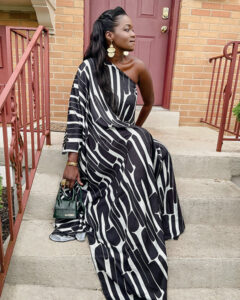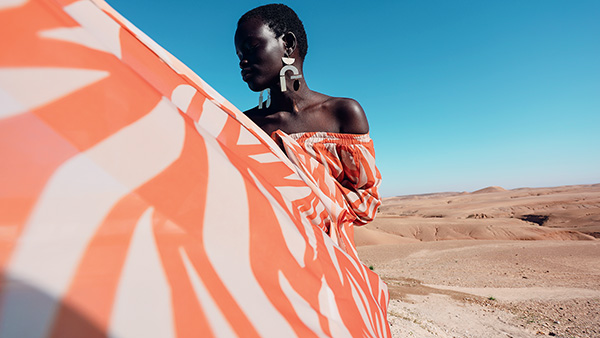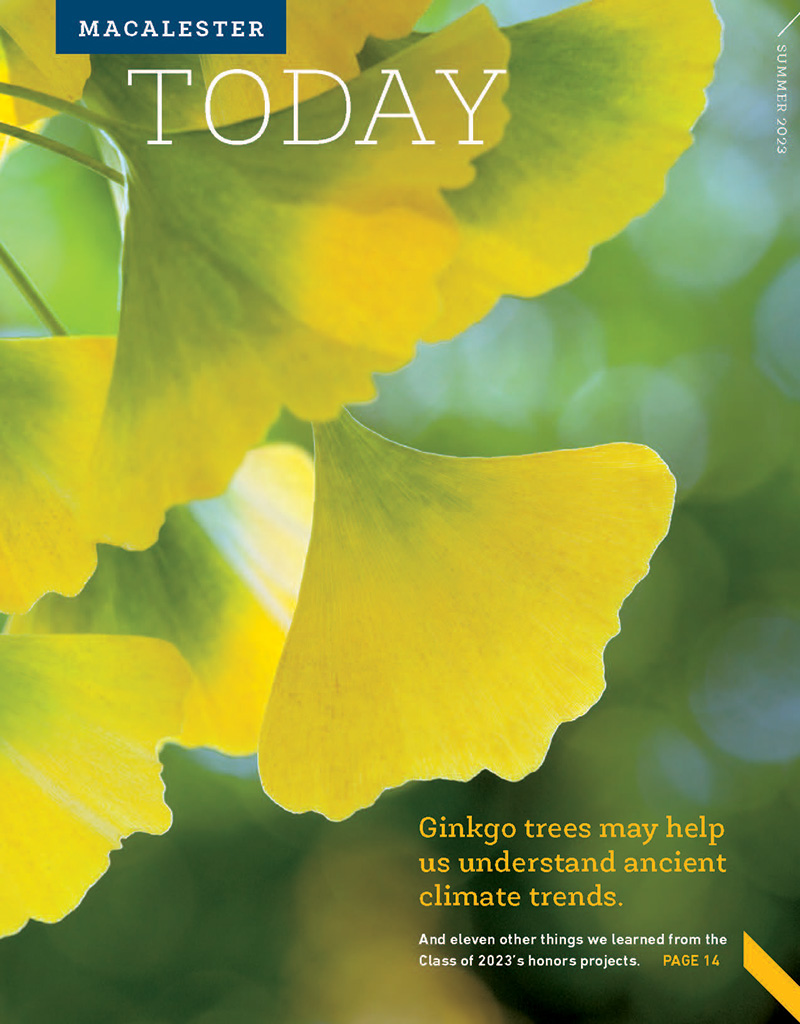
By Brittany King / Photos courtesy of Diarra Bousso
 Growing up in Dakar, Senegal, Diarra Bousso ’11 was surrounded by art and beautiful clothing. “There is so much creativity all around Dakar,” she says. “My father would bring home beautiful art from local artists and my mother was always a style inspiration.”
Growing up in Dakar, Senegal, Diarra Bousso ’11 was surrounded by art and beautiful clothing. “There is so much creativity all around Dakar,” she says. “My father would bring home beautiful art from local artists and my mother was always a style inspiration.”
Bousso often retreated to her room to create pieces of her own. Writing, painting, styling, editing, she did it all, drawing on her natural creativity and problem-solving ability.
Those moments of creativity led to the launch of her clothing and accessories company, DIARRABLU. Bousso, who holds the intriguing title of chief creative mathematician, describes DIARRABLU as a sustainable lifestyle brand that highlights the beauty of African countries through rich colors, patterns, and design that relies on mathematical concepts and algorithms. The name of the company is a fusion of Bousso’s first name and the word “Blue” without an “e.” She says Blu evokes the feeling of infinity when you gaze upon the ocean. DIARRABLU, which has been featured in the New York Times and Vogue magazine, is a merging of Bousso’s love of numbers, passion for art, and inspiration from her home country of Senegal.
The company’s design philosophy is deeply tied to Senegalese culture because every design is versatile and allows for multiple uses. For example, wrap skirts and boubou dresses that are popular in Senegal also are popular with DIARRABLU customers. Design that’s not focused on buttons and zippers ensures clothing can be worn in a variety of ways, and across sizes. It also promotes sustainability, as the pieces can be adapted—rather than discarded—as trends change.
Before she launched an international brand, Bousso was an economics and mathematics major at Macalester who dreamed of following in her father’s banking footsteps. During her sophomore year, she took an Investment Banking class with Professor Joyce Minor ’88 that she says was the catalyst for her first career on Wall Street. “Joyce helped me gain a strong understanding of finance and became an amazing mentor. To this day, I still reach out to her when making important life decisions,” she says.
As Bousso learned about securities analysis and the impact that finance has on the world, she gained confidence in her skills. She landed a prestigious internship at Credit Suisse, an investment banking company, at just twenty years old.
The internship led to an opportunity to work on the trading floor where she was one of very few young women of color. She received a full-time offer from Credit Suisse to become a trading analyst upon graduation.
While her two years on Wall Street were a significant phase of growth for Bousso, she quickly realized her heart belonged elsewhere. The work didn’t excite her. She pursued her passion for art and fashion by starting a street-style photography blog on the side.
By 2013 Bousso was experiencing depression and questioning her next steps. Encouraged by her family to take a break and move home to figure things out, she quit her job, packed her bags, emptied her 401K, and decided to bet on herself. A month after moving home, she launched DIARRABLU.
In the company’s early stages, she worked with an artisan in Senegal to create dresses in her home, using her sisters as models. She’d post everything on Instagram to solicit feedback, and eventually sell the clothes. As her online community grew, so did the demand for her dresses.
Simultaneously, Bousso pursued a passion for education and for more entrepreneurship. Over the next decade, she became a teaching assistant in Senegal, founded several additional companies, and moved to California to earn a graduate degree in mathematics at Stanford University. She says it was while working full time as a teacher following grad school that she learned to merge creativity with mathematics and transform DIARRABLU into a fashion tech company.
Bousso began incorporating math equations and concepts into the company’s textile patterns. This decision resulted in designs that are both economical and consciously made by local artisans in Senegal. Her math-based design process allows her to create one-hundred times faster and at a fraction of the cost. And because all of DIARRABLU’s pieces are made to order, the brand avoids wasting money on product that never sells.
Bousso uses a combination of manual equation writing, AI, machine learning, and hand-painted designs to create her patterns. When she creates a new design, she often writes equations instead of drawing shapes, which is typically how fabric patterns and clothing are made. By using math-graphing software and writing equations with parameters, rather than specific numbers, she’s able to create a variety of silhouettes in different sizes with endless color possibilities. She then takes these equation-created designs, renders them on digital models, and shares them with her online community for feedback.
“That’s what makes us stand out,” she says. By getting customer buy-in before going into production, DIARRABLU can reduce waste in an industry known to be the second most polluting in the world.
Now Bousso hopes to extend DIARRABLU’s product line to home goods and accessories, still using the same mathematical design philosophy and providing more ethical and sustainable options. Today she is based in San Francisco, leading her global company of fifty people from all corners of the world.
Bousso credits her time at Macalester for shaping her in ways she didn’t know she’d need for her entrepreneurial journey.
“Mac made me feel welcomed and celebrated in my rich and unique multicultural identity, something I continue to seek in new spaces,” she says. “I’ve been able to create that environment at my own company.”

Brittany King is a Chicago-based writer and independent journalist.
July 18 2023
Back to top





